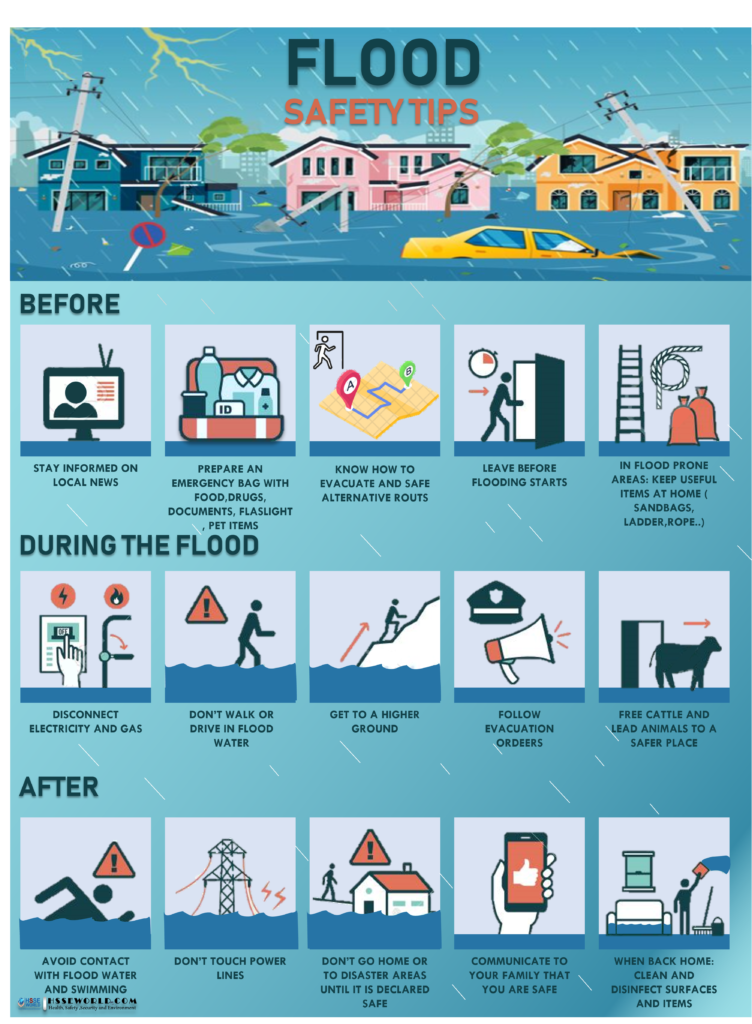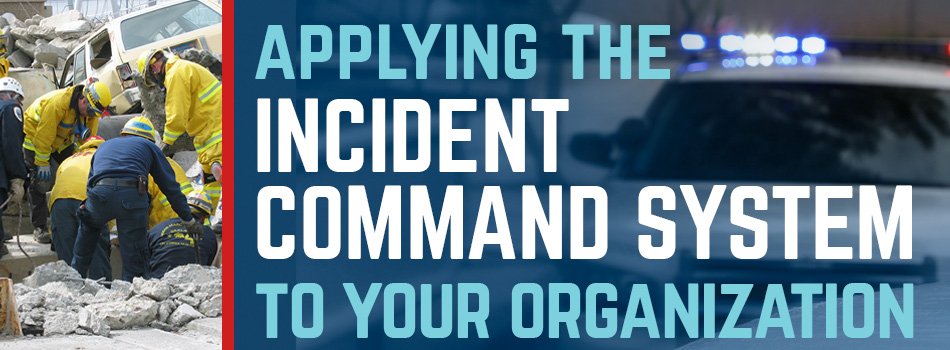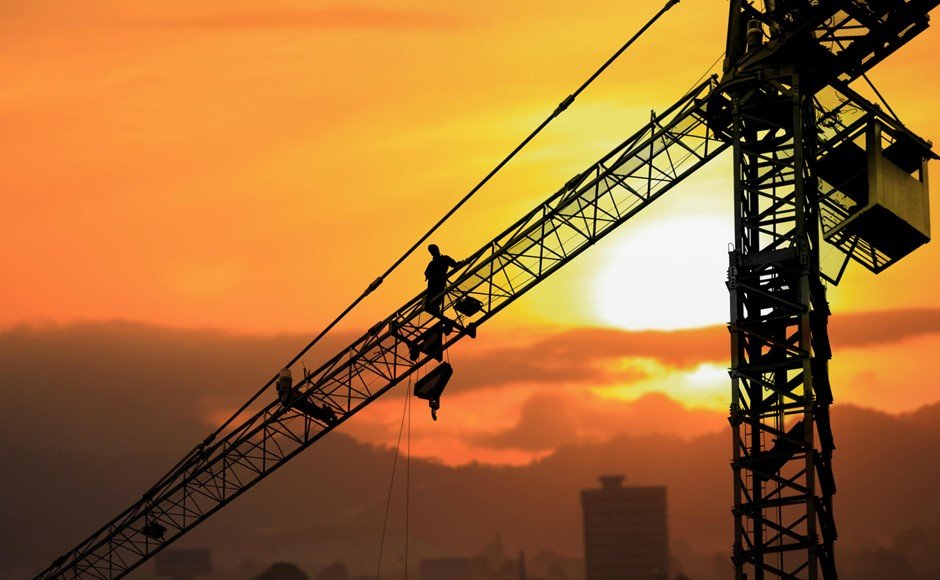Flooding is a temporary overflow of water onto land that is normally dry. Floods are the most common natural disaster in many countries. Failing to evacuate flooded areas or entering floodwaters can lead to injury or death.( flood safety )
Floods may:
- Result from rain, snow, coastal storms, storm surges and overflows of dams and other water systems.
- Develop slowly or quickly. Flash floods can come with no warning.
- Cause outages, disrupt transportation, damage buildings and create landslides.
In the photo of today, “Flood safety Tips “you will learn how to prepare for a flood, stay safe during a flood, and protect your health when you return home after a flood.
( Read : Be Ready for Severe Weather during Construction works )

What Are Floods?
Flooding is an overflow of water that can range from a few inches deep to fully submerging entire buildings. Flooding can occur when rivers and lakes cannot contain excessive rain or snowmelt, or when rain cannot be absorbed fully into the ground. Flooding can also occur when waterways overflow due to debris or ice, when winds from tropical storms or hurricanes cause storm surges in coastal areas, or when water containment systems (such as levees, dams, pipes) break.
Why Prepare?
Flooding is the most common hazard in Massachusetts. Some floods develop slowly, while flash floods can occur within minutes or hours after a storm or containment system breaks.
Flood Watches and Warnings
It is important to understand the difference between watching and warning so you know what to do to stay safe.
Flood Watch or Flash Flood Watch
Flooding or flash flooding in your area is possible. Pay attention to changing weather and flood conditions, and be prepared to move to higher ground.
Thunderstorm and Lightning Preparedness
Flood Warning
Flooding is occurring or about to occur. Avoid low-lying areas and if necessary, evacuate.
Flash Flood Warning
A flash flood is occurring or about to occur. Seek higher ground immediately.
What to Do Before a Flood
- Be informed by receiving alerts, warnings, and public safety information before, during, and after emergencies.
- Find out whether your property is in a flood-prone or high-risk area. Explore the Emergency Management Agency’s flood maps.
- Contact your local Emergency Management Director to find out if your home or workplace is downstream from a dam and learn more about your community’s risk of flooding.
- Create and review your family emergency plan.
- Have a plan to go to higher ground quickly if necessary.
- If you live or work in a flood zone, hurricane evacuation zone, or an area that is prone to flooding, you should be prepared to evacuate.
- Make a record of your personal property by taking photos or videos of your belongings. Store these records in a safe place.
- Prepare your home for flooding.
- Flood losses are not typically covered under renter and homeowner’s insurance policies. Consider purchasing flood insurance through the National Flood Insurance Plan (NFIP). Flood insurance is available in most communities whether or not your building is in a flood-prone area, but there is a 30-day waiting period before it goes into effect.
- Assemble an emergency kit.Gather emergency supplies, including food and water. Store at least 1 gallon of water per day for each person and each pet. Store at least a 3-day supply.
- Listen to your local radio or television station for updates.
- Have immunization records handy (or know the year of your last tetanus shot).
- Store immunization records in a waterproof container.
- Bring in outdoor possessions (lawn furniture, grills, trash cans) or tie them down securely.
- If evacuation appears necessary, turn off all utilities at the main power switch and close the main gas valve.
- Leave areas subject to flooding such as low spots, canyons, washes, etc. (Remember: avoid driving through flooded areas and standing water.)
What to do During a Flood Watch or Flash Flood Watch
- Listen to a National Oceanic and Atmospheric Administration (NOAA) Weather Radio or to a local news station for the latest information.
- Follow instructions given by public safety officials.
- Be alert to changing weather conditions and be ready to move to higher ground.
- Consider postponing outdoor activities.
- Tie down or bring in outdoor objects (patio furniture, children’s toys, trash cans, etc.) that could be swept away or damaged during flooding.
- Consider unplugging sensitive electronic equipment before flooding occurs. But, do not touch electrical equipment if you are wet or standing in water.
- Elevate items stored in your basement to prevent damage. If you have a sump pump, check that it is working.
- Consider clearing street catch basins to prevent or reduce street flooding.
- Avoid camping or parking along streams, rivers, creeks, or other areas prone to flooding during heavy rainfall. These areas can flood rapidly and with little warning.
What to do During a Flood Warning or Flash Flood Warning
- Move immediately to higher ground or stay on high ground.
- Continue to check the media for emergency information.
- Follow instructions from public safety officials.
- If advised to evacuate, do so immediately.
- If you must evacuate your home, take only essential items and bring your pets if safe to do so.
- If you must evacuate or are traveling during flooding, remember:
- Do not walk through flowing water. Most drownings occur during flash floods. Six inches of swiftly moving water can knock you off of your feet.
- Remember the phrase “Turn Around, Don’t Drown!” Don’t drive through flooded roads. Cars can be swept away in only two feet of moving water. If your vehicle is trapped in rapidly moving water, stay in the vehicle. If the water is rising inside the vehicle, seek refuge on the roof.
- Do not drive around road barriers. Roads and bridges may be washed out or structurally unsound.
- If told to shelter in place, listen to local television or radio for updates. Conditions may change quickly, so be prepared to evacuate to a shelter or a neighbor’s home if necessary.
What to do After a Flood
- Continue to monitor the media for emergency information.
- Follow instructions from public safety officials.
- If you have evacuated, return home only when authorities say it is safe to do so.
- Call Emergency Contact Number to report emergencies including downed power lines and gas leaks.
- Call Emergency Contact Number to obtain shelter locations and other disaster information.
- Be a good neighbor. Check on family, friends, and neighbors, especially the elderly, those who live alone, those with medical conditions, and those who may need extra help.
Flood Safety
- Stay away from downed utility wires. Always assume a downed power line is live. Electrocution is also a serious danger in floods as electrical currents can travel through water.
- “Turn Around, Don’t Drown!” – Don’t drive through flooded roads.
- Stay out of damaged buildings and away from affected areas or roads until authorities deem them safe.
- If your power is out, report outages to your utility company and follow power outage safety tips.
- Look before you step. Debris, including broken bottles and nails can cover the ground and floors after a flood. Mud covered floors and stairs can be slippery.
- Listen to news reports to learn if your water supply is safe to drink. Until local authorities say your water supply is safe, boil water for at least one minute before drinking or using it for cooking.
- Throw away food (including canned items) that has come in contact with floodwaters. Don’t eat food from flooded gardens. Throw away any refrigerated food that was not kept at temperatures above 40 °F for more than two hours or that has an unusual odor, color, or texture.
Clean Up Your Home and Check for Damage
- Check your home for damage:
- Never touch electrical equipment while you are wet or standing in water. Consider hiring a qualified electrician to assess damage to electrical systems.
- Have wells checked for contamination from bacteria and chemicals before using.
- Have damaged septic tanks or leaching systems repaired as soon as possible to reduce potential health hazards.
- If your home or property is damaged, take photos or videos to document your damage, and contact your insurance company.
- Avoid entering moving or standing floodwaters. Floodwater and mud may be contaminated by oil, gasoline, or raw sewage.
- Clean and disinfect anything that got wet. Take precautions. Wear appropriate protective equipment such as gloves, safety glasses, and face masks.
- Flooded floors and walls should be washed with a solution of two capfuls of household bleach for each gallon of water.
- Carpeting, mattresses, and upholstered furniture should be disposed of or disinfected by a professional cleaner.
- Remove and replace any drywall or other paneling that has been underwater. Use a moisture meter to make sure that wooden studs and framing are dry before replacing the drywall. Mold growth in hidden places is a significant health hazard.
- Consider using professional cleaning and repair services before attempting to repair flood-damaged property.
Electrical Safety While Working From Home: Safety Moment#30
Now you can download the Infographic ” Flood Safety Tips” and post it at the workplace and communicate with everyone to be familiar with Flood Safety Tips
Download the infographic
Flood Safety Tips
More Photos
- What are the Best Practices for Managing Subcontractor Risk
- Photo of the day: 10 Essential Safety Tips for Driving in Hot Weather Conditions
- Photo of the day: best workplace safety tips
- Photo of the day: The Importance of Stop Work Authority in Maintaining Workplace Safety
- Photo of the day: Tomorrow’s Reward for Working Safely Today: Cultivating a Culture of Safety
- Photo of the day: Preventing slips and trips at work
- Photo of the day: Learn the DRSABCD action Plan
- Working with Electricity Electrical Accidents Guide for Electrical Workers
- Photo of the day: Hearing Protection Device Selection
- Photo of the day: If An Earthquake Shakes You-Infographic free
- Fire Safety Posters Free Download
- Photo of the day: First Aid for Electrical Burns-Infographic free
- Infographic: First Aid for Cuts and Scrapes free download
- Photo of The day: Work Safe with Lasers-Laser Safety free
- Photo of the day: Working Safely with chemicals and chemical Management
- Photo of the day: Safe work practices when using MEWPs ( updated)
- Photo of the day: Preventing Common Kitchen Hazards
- Photo of the day: Safe handling of Gas Cylinders and lecture bottles
- Photo of the day: Forklift Stability Triangle
- Photo of the day: Defective Tools Safe Work Practice
- Photo of the day: Lift With Your Legs Not With Your Back
- Photo of the day: First Aid for burns
- Photo of the day: The 7 Principles of HACCP
- Photo of the day: Working Safely with Suspended Loads
- Photo of the day: Heat Stroke First Aid and safety posters
- Photo of the day: Near-Miss Reporting and Posters
- Photo of the day: Ergonomic chair and office chair safety tips
- Photo of the day: Whole Body Vibration
- Photo of the day: Substation Safety Equipment
- Photo of the day: Bypassing Safety Controls Rules
- Photo of the day: Lightning Safety Tips
- Photo of the day: Overhead Power lines Clearance
- Photo of the day: Floor Marking
- Photo of the day: Types of Foot Protection
- Photo of the day: Types of Hand Protection
- Photo of the day: Lockout and Tagout Safety
- Photo of the day: Fall Protection Plans
- Photo of the day: Flood Safety Tips
- Photo of the day: Read All Labels Work safe
- Photo of the day: Run Project safely with Crane Hand Signals
- Photo of the day: Flagman and Traffic control
- Photo of the day: Managing Risks of Exposure to Solvents in the workplace
- Photo of the day: Scissor Lift Safety
- Photo of the day: HSE Bulletin Board
- Photo of the day: Arc-Fault Circuit Interrupters (AFCI)
- Photo of the day: Safe use of ladders and step ladders
- Photo of the day: Concrete Truck Driver Hand Signals
- Photo of the day: Extension Cord Safety Tips
- Photo of the day: Protect your Head
- Photo of the day: choosing the right Anchorage
- Photo of the day: Work-Related Asthma
- Photo of the day: Top FIVE Heavy Equipment Construction Site Safety Tips
- Photo of the day: sun safety in the workplace
- Photo of the day: Cannabis and Impairment in the Workplace
- Photo of the day: Position for safety and comfort-Safety Tips
- Photo of the day: Generator Safety
- Photo of the day: Controlling COVID-19 in the Workplace-Physical Barriers
- Photo of the day: Manual Material handling
- Photo of the day: Personal Protective Equipment last resort
- Photo of the day: WHMIS 2015 – Pictograms
- Photo of the day: Indoor Air Quality
- Photo of the day: Noise in the affected workplace
- Photo of the day: Fatigue at Work
- Photo of the day: Don’t be Driven to Distraction
- Photo of the day: working in heat and Humidex Rating
- How to use Plate Clamps Safely: Safety Moment#34
- Photo of the day: Sitting at work
- Photo of the day: 5 ways to reduce the risk of Slipping and Tripping
- Photo of the day: Preventing the spread of contagious illness
- Photo of the day: Incident Investigations
- Photo of the day: 10 Scaffold Safety Essentials
- Photo of the day: Effective Health and Safety Committees
- Photo of the day: New worker Orientation & Safety Orientation checklist
- Photo of the day: Workplace Inspection
- Photo of the day: musculoskeletal disorders
- Photo of the day: Emergency preparedness in the workplace
- Photo of the day: Mental health in the workplace
- Photo of the day: Trenching Safety Tips That Can Save a Life




